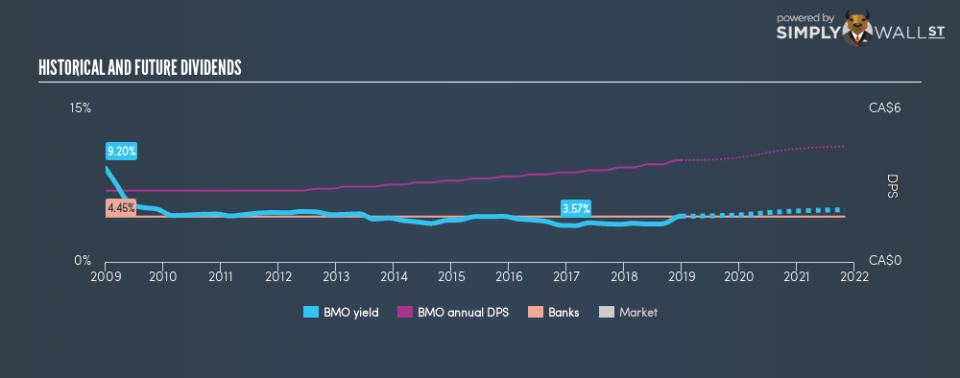Does Bank of Montreal (TSE:BMO) Have A Place In Your Portfolio?

Bank of Montreal (TSE:BMO) has pleased shareholders over the past 10 years, by paying out dividends. The company currently pays out a dividend yield of 4.5% to shareholders, making it a relatively attractive dividend stock. Should it have a place in your portfolio? Let’s take a look at Bank of Montreal in more detail.
View our latest analysis for Bank of Montreal
5 checks you should do on a dividend stock
When assessing a stock as a potential addition to my dividend Portfolio, I look at these five areas:
Is its annual yield among the top 25% of dividend-paying companies?
Has its dividend been stable over the past (i.e. no missed payments or significant payout cuts)?
Has dividend per share amount increased over the past?
Is is able to pay the current rate of dividends from its earnings?
Based on future earnings growth, will it be able to continue to payout dividend at the current rate?
How does Bank of Montreal fare?
The company currently pays out 46% of its earnings as a dividend, according to its trailing twelve-month data, meaning the dividend is sufficiently covered by earnings. In the near future, analysts are predicting a payout ratio of 43% which, assuming the share price stays the same, leads to a dividend yield of around 4.8%. Moreover, EPS should increase to CA$9.47.
When assessing the forecast sustainability of a dividend it is also worth considering the cash flow of the business. A company with strong cash flow, relative to earnings, can sometimes sustain a high pay out ratio.
If there’s one type of stock you want to be reliable, it’s dividend stocks and their stable income-generating ability. BMO has increased its DPS from CA$2.8 to CA$4 in the past 10 years. During this period it has not missed a payment, as one would expect for a company increasing its dividend. This is an impressive feat, which makes BMO a true dividend rockstar.
Compared to its peers, Bank of Montreal generates a yield of 4.5%, which is high for Banks stocks but still below the market’s top dividend payers.
Next Steps:
Taking into account the dividend metrics, Bank of Montreal ticks most of the boxes as a strong dividend investment, putting it in my list of top dividend payers. Given that this is purely a dividend analysis, I recommend taking sufficient time to understand its core business and determine whether the company and its investment properties suit your overall goals. There are three fundamental aspects you should further examine:
Future Outlook: What are well-informed industry analysts predicting for BMO’s future growth? Take a look at our free research report of analyst consensus for BMO’s outlook.
Valuation: What is BMO worth today? Even if the stock is a cash cow, it’s not worth an infinite price. The intrinsic value infographic in our free research report helps visualize whether BMO is currently mispriced by the market.
Other Dividend Rockstars: Are there better dividend payers with stronger fundamentals out there? Check out our free list of these great stocks here.
To help readers see past the short term volatility of the financial market, we aim to bring you a long-term focused research analysis purely driven by fundamental data. Note that our analysis does not factor in the latest price-sensitive company announcements.
The author is an independent contributor and at the time of publication had no position in the stocks mentioned. For errors that warrant correction please contact the editor at editorial-team@simplywallst.com.

 Yahoo Finance
Yahoo Finance 
